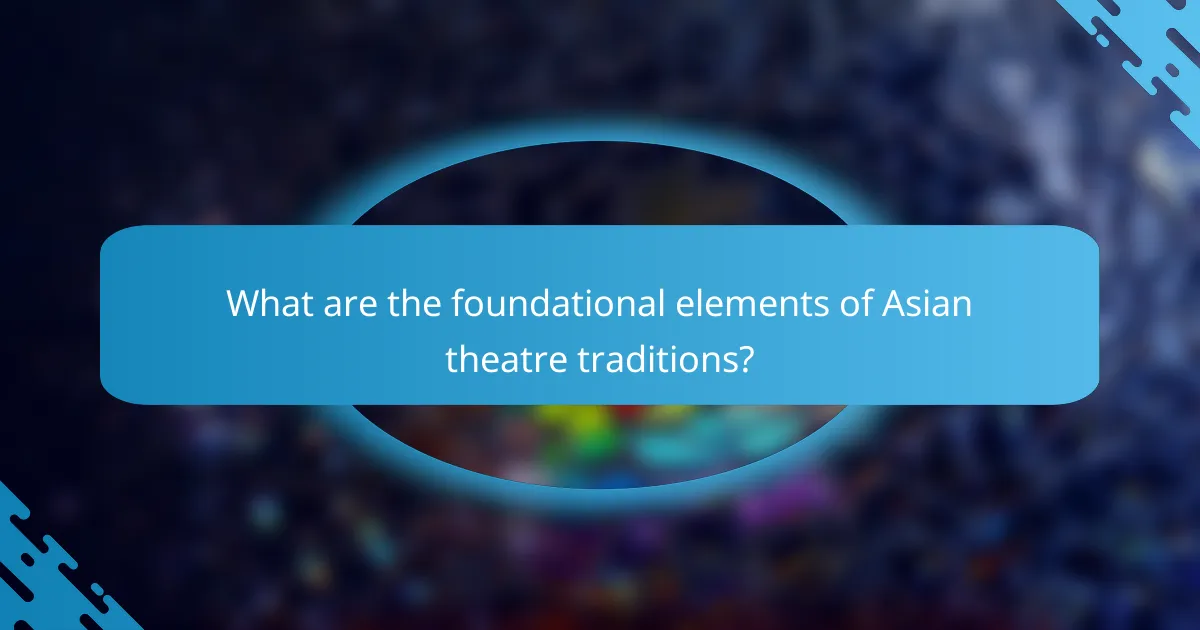Asian theatre traditions encompass storytelling, music, dance, and visual aesthetics, serving as foundational elements that convey cultural narratives and societal values. These traditions have significantly influenced Western performance styles through techniques such as physicality, stylized movement, and ensemble performance, enriching contemporary theatre. The integration of elaborate staging from Kabuki, the minimalism of Noh, and the musical elements of Chinese opera has shaped Western dramatic structures and aesthetics. This article explores the profound impact of Asian theatre on Western performance, highlighting key techniques and cultural exchanges that have occurred over the years.

What are the foundational elements of Asian theatre traditions?
The foundational elements of Asian theatre traditions include storytelling, music, dance, and visual aesthetics. Storytelling is central, often conveying moral and philosophical themes. Music enhances the emotional experience and sets the tone for performances. Dance is integral, often embodying cultural narratives and rituals. Visual aesthetics, including costumes and stage design, create immersive environments. These elements are deeply rooted in cultural history and reflect societal values. For example, traditional Chinese opera incorporates all these aspects to convey complex narratives. Similarly, Indian classical theatre utilizes dance and music to express spiritual themes. Each tradition maintains unique characteristics while sharing common foundational elements.
How do cultural contexts shape Asian theatre practices?
Cultural contexts significantly shape Asian theatre practices through historical, social, and religious influences. These contexts define the themes, performance styles, and audience interactions in various Asian traditions. For instance, the influence of Confucianism in Chinese theatre emphasizes moral lessons and social hierarchy. In India, the spiritual roots of Bharatanatyam connect dance with religious storytelling.
Additionally, regional languages and dialects affect the narrative techniques used in performances. Traditional forms often reflect local customs, festivals, and rituals. The incorporation of folk tales and myths showcases cultural identity and heritage.
Moreover, globalization introduces new elements while preserving traditional aspects. This blend influences contemporary Asian theatre, making it dynamic and relevant. Historical events, such as colonialism, also impact themes and styles, leading to unique adaptations.
Overall, cultural contexts are foundational in developing and evolving Asian theatre practices.
What are the key characteristics of traditional Asian theatre forms?
Traditional Asian theatre forms are characterized by their unique integration of performance elements, storytelling techniques, and cultural significance. They often feature stylized movements and gestures, emphasizing physical expression over realistic portrayal. Music and dance are integral components, enhancing the emotional depth of the narratives.
Moreover, traditional Asian theatre frequently employs elaborate costumes and makeup, which symbolize characters and their roles. The use of masks is common in certain forms, such as Noh and Kabuki, adding layers of meaning. Additionally, these theatre forms often draw from historical and mythological sources, reflecting cultural values and collective memory.
The performance space is typically designed to create an immersive experience, often blending with the audience. Ritualistic elements are also present, linking the performance to spiritual or communal practices. Thus, traditional Asian theatre forms encapsulate a rich tapestry of cultural heritage, artistry, and community engagement.
How do storytelling methods differ across Asian theatre traditions?
Storytelling methods differ significantly across Asian theatre traditions. Each tradition employs unique techniques and narrative structures. For instance, Japanese Noh theatre emphasizes minimalism and symbolic gestures. In contrast, Indian Kathakali relies on elaborate costumes and [censured] expressions to convey stories. Chinese opera integrates music, acrobatics, and stylized movements. Furthermore, Balinese theatre incorporates intricate puppetry and ritualistic elements. These differences reflect cultural values and historical contexts within each tradition. The diversity in storytelling methods showcases the rich tapestry of Asian theatrical arts.
What role does performance style play in Asian theatre?
Performance style is crucial in Asian theatre as it conveys cultural narratives and traditions. It encompasses unique techniques, movements, and vocal styles that define the genre. Each Asian theatre form, such as Noh, Kabuki, or Kathakali, employs distinct performance styles. These styles reflect historical contexts and social values. For instance, Noh theatre emphasizes minimalist movements to evoke deep emotions. Kabuki, on the other hand, incorporates elaborate costumes and exaggerated expressions for dramatic effect. The performance style also aids in audience engagement, creating a shared cultural experience. This engagement fosters a connection between performers and spectators, enhancing the overall impact of the performance.
How does physicality influence performance in Asian theatre?
Physicality significantly influences performance in Asian theatre by shaping the expression and communication of emotions. This aspect is essential in various traditional forms, such as Noh, Kabuki, and Kathakali. In these styles, actors use precise bodily movements to convey narrative and character emotions. For instance, in Kathakali, elaborate gestures and [censured] expressions are integral to storytelling. The physicality also includes the use of space and movement patterns, which enhance dramatic tension and audience engagement. Research shows that this emphasis on physicality can lead to a deeper connection between performers and their audience. The training in these traditions often focuses on body control and discipline, resulting in performances that are visually striking and emotionally resonant.
What are the unique vocal techniques used in Asian theatre?
Unique vocal techniques in Asian theatre include specific forms such as “kata” in Japanese Noh, which emphasizes controlled, minimalistic expression. Another technique is “khon” in Thai theatre, characterized by intricate vocalizations and rhythmic chanting. In Chinese opera, “sheng” refers to the male vocal role, using distinct pitch variations and resonance. These techniques often reflect cultural storytelling traditions. They enhance emotional depth and character portrayal in performances. Historical context shows that these vocal forms have been preserved for centuries, influencing modern theatrical practices. The precision and discipline in these techniques contribute to their uniqueness.

How have Asian theatre traditions influenced Western performance styles?
Asian theatre traditions have significantly influenced Western performance styles through techniques, aesthetics, and narrative forms. The incorporation of elements such as physicality and stylized movement from Asian theatre is evident in contemporary Western choreography. Techniques like Noh and Kabuki have introduced the use of masks and elaborate costumes, enhancing visual storytelling. Additionally, the concept of ensemble performance from Asian traditions has encouraged collaborative approaches in Western theatre. The use of symbolism and non-linear narratives has also been adopted, enriching Western dramatic structures. These influences can be traced back to cultural exchanges in the 20th century, particularly during the rise of global theatre festivals. Notable figures, such as Peter Brook, have acknowledged the impact of Asian theatre on their work, further validating this influence.
What are the key similarities between Asian and Western performance styles?
Asian and Western performance styles share several key similarities. Both emphasize storytelling as a central element. They utilize character development to engage the audience. Emotional expression is a crucial aspect in both traditions. Additionally, both styles often include the use of music and dance to enhance the narrative. Collaborative efforts among performers are common in both settings. Furthermore, the integration of visual elements, such as costumes and staging, is significant in both styles. These similarities highlight the universal nature of performance as a means of communication and cultural expression.
How have elements of Asian theatre been integrated into Western narratives?
Elements of Asian theatre have been integrated into Western narratives through various forms such as storytelling, aesthetics, and performance techniques. The incorporation of Asian aesthetics is evident in the use of visual elements like elaborate costumes and stage design. Techniques from Asian theatre, such as physical acting styles and use of symbolism, have influenced Western performance. Notable examples include the adoption of Kabuki and Noh elements in modern theatre productions. Additionally, playwrights like David Henry Hwang have blended Asian narratives with Western themes. The fusion of these elements enhances the richness of Western storytelling. This integration reflects a growing appreciation for diverse cultural expressions in the arts.
What impact has Asian theatre had on Western acting techniques?
Asian theatre has significantly influenced Western acting techniques. Techniques such as physical expression and improvisation have been adopted from Asian traditions. The use of stylized movement in Kabuki and Noh has inspired Western performers. Additionally, the emphasis on emotional authenticity in Asian theatre has shaped method acting. The integration of ensemble work from Asian practices has improved Western collaborative performances. Furthermore, the incorporation of ritualistic elements from Asian theatre has enriched Western storytelling. These influences have led to a more diverse and expressive approach in Western acting. Overall, Asian theatre has broadened the scope of performance styles in the West.
Why is it important to study the influence of Asian theatre on Western performance?
Studying the influence of Asian theatre on Western performance is crucial for understanding cultural exchange. Asian theatre traditions have introduced unique storytelling techniques and aesthetic principles to Western art forms. These influences can be seen in the works of playwrights and directors who incorporate elements like non-linear narratives and physical movement. For instance, the use of masks and stylized movement in Kabuki has inspired contemporary Western theatre. Historical interactions, such as the introduction of Noh theatre in the 19th century, have shaped modern performance practices. Additionally, this study fosters appreciation for diversity in artistic expression. Understanding these influences enriches both the performers and the audience by broadening the scope of theatrical language.
How does this influence contribute to cultural exchange in the arts?
Asian theatre traditions influence cultural exchange in the arts by introducing diverse performance techniques and storytelling methods. These traditions, such as Noh and Kabuki, emphasize movement, music, and visual aesthetics. Western artists adopt these elements to enhance their own performances. This cross-pollination fosters innovation in theatrical expressions. For instance, the incorporation of Asian martial arts into choreography has transformed Western dance. Collaborations between Asian and Western artists create hybrid art forms. These exchanges promote mutual understanding and appreciation of different cultures. Historical examples include the Broadway adaptation of “The King and I,” which showcases Asian influences in Western theatre.
What can contemporary Western theatre learn from Asian traditions?
Contemporary Western theatre can learn several techniques and philosophies from Asian traditions. Asian theatre often emphasizes physicality and movement, which can enhance the expressiveness of performances. The use of masks in Asian traditions, such as Noh and Balinese theatre, allows for a deeper exploration of character and emotion.
Additionally, the integration of music and dance in performances creates a multi-sensory experience that engages audiences more fully. The concept of storytelling in Asian theatre often prioritizes communal experience over individual narratives, fostering a sense of collective engagement.
Moreover, the spiritual and philosophical underpinnings of traditions like Kabuki and Kathakali can inspire Western theatre to explore deeper themes of existence and human connection. The emphasis on ritual in Asian performances can also provide Western theatre with new ways to structure and present narratives.
Finally, the visual aesthetics and design elements in Asian theatre, such as elaborate costumes and stage settings, can influence Western production design, enhancing visual storytelling. These lessons can lead to a richer and more diverse theatrical landscape in contemporary Western theatre.

What are the specific examples of Asian theatre’s impact on Western performance?
Asian theatre has significantly influenced Western performance through various styles and techniques. Kabuki theatre introduced elaborate staging and makeup, which inspired Western theatrical productions. The use of physicality and stylized movement in Chinese opera has impacted Western choreography. Noh theatre’s focus on minimalism and symbolism has shaped modern Western drama’s aesthetic. Additionally, the storytelling techniques in Asian theatre have influenced narrative structures in Western plays. The incorporation of Asian musical elements has enriched Western compositions. These examples demonstrate the profound and ongoing impact of Asian theatre on Western performance.
How have specific Asian theatre forms been adopted in Western productions?
Asian theatre forms have been adopted in Western productions through various adaptations and integrations. Notable examples include the incorporation of elements from Japanese Noh and Kabuki theatre. Western directors often utilize the stylized movements and aesthetics of these forms. This integration enhances visual storytelling and emotional depth.
Additionally, Chinese opera influences Western theatre through its elaborate costumes and makeup. Productions such as “The King and I” reflect this cultural exchange. The use of Asian musical scales and rhythms has also been integrated into Western scores.
Moreover, contemporary plays and musicals frequently draw upon Asian narratives and themes. This trend signifies a growing appreciation for diverse cultural expressions. The blending of these traditions enriches the theatrical landscape in the West.
What notable Western performances have drawn inspiration from Asian theatre?
Notable Western performances that have drawn inspiration from Asian theatre include “The King and I” and “Miss Saigon.” “The King and I,” which premiered in 1951, is based on the true story of Anna Leonowens and her experiences in the royal court of Siam. The musical incorporates elements of Thai culture and traditional dance. “Miss Saigon,” which debuted in 1989, draws from the Vietnamese experience during the Vietnam War. It is influenced by the story of Puccini’s opera “Madama Butterfly,” reflecting themes of love and sacrifice. Both productions showcase how Western theatre has integrated Asian narratives and aesthetics.
How have Asian performance techniques been adapted in Western contexts?
Asian performance techniques have been adapted in Western contexts through integration into various art forms. Techniques such as physical movement, vocal expression, and storytelling have influenced Western theater, dance, and film. For instance, the use of mime and exaggerated gestures from Asian traditions has enhanced physical theater in the West. Additionally, elements of Japanese Noh and Kabuki have been incorporated into contemporary performances. The fusion of these styles is evident in productions like “The Lion King,” which blends African and Asian theatrical elements. Workshops and collaborations between Asian and Western artists have further facilitated this exchange. Events like the Asia Society’s performances showcase these adaptive practices. Overall, the adaptation reflects a growing appreciation for diverse cultural expressions in the performing arts.
What are the challenges and opportunities in blending Asian and Western theatre styles?
Blending Asian and Western theatre styles presents both challenges and opportunities. One challenge is the cultural differences that may lead to misunderstandings. For instance, Western theatre often emphasizes individualism, while Asian traditions may focus on collectivism. This can create tension in creative collaboration. Another challenge is the varying performance aesthetics. Asian theatre frequently employs stylized movements and gestures, while Western styles may prioritize realism.
Opportunities arise from the fusion of diverse techniques. Combining narrative structures can enhance storytelling. The integration of unique visual elements can create innovative stage designs. Collaborations can lead to new forms of expression that resonate with broader audiences. Successful examples include productions like “The Lion King,” which incorporates elements from both cultures. This blending can enrich the theatrical landscape, drawing on the strengths of both traditions.
What are the potential cultural misinterpretations in this blending process?
Cultural misinterpretations in the blending process of Asian theatre traditions and Western performance styles can occur due to differing cultural contexts. Western audiences may misinterpret gestures or symbols rooted in Asian traditions. These gestures can carry specific meanings in their original context that may not translate accurately. Additionally, the aesthetic values of performance may differ significantly. This can lead to misunderstandings of intent or emotional expression.
For instance, the use of silence in Asian theatre often signifies contemplation, while in Western theatre it may be perceived as awkwardness. Historical context is also crucial; Western interpretations may overlook the significance of cultural heritage in Asian performances. Furthermore, commercial adaptations may dilute original meanings, causing further misinterpretation.
These cultural misinterpretations highlight the importance of cultural sensitivity and awareness in the blending process. Understanding the nuances of each tradition can help mitigate these issues.
How can artists effectively merge these diverse performance traditions?
Artists can effectively merge diverse performance traditions by incorporating elements from each tradition into a cohesive work. They should study the cultural significance and techniques of both Asian and Western styles. Understanding the historical context enhances authenticity in the fusion. Collaboration with practitioners from both traditions fosters innovation. Utilizing hybrid techniques, such as blending movement styles or narrative forms, creates unique expressions. For instance, incorporating Asian physicality into Western storytelling can enrich the performance. Successful examples include productions like “The Lion King,” which integrates various cultural elements. This approach promotes cross-cultural dialogue and appreciation.
What practical steps can theatre practitioners take to incorporate Asian influences?
Theatre practitioners can incorporate Asian influences by studying traditional Asian performance techniques. They can attend workshops focused on Asian theatre forms, such as Noh, Kabuki, or Bharatanatyam. Collaboration with Asian artists can provide authentic insights and perspectives. Practitioners should also analyze scripts and narratives from Asian cultures for adaptation. Integrating traditional Asian music and instruments can enhance the performance’s authenticity. Practitioners may explore the use of movement and physical expression characteristic of Asian theatre. Incorporating visual elements, such as Asian-inspired sets and costumes, can further enrich the production. Engaging with the cultural contexts and histories behind these traditions is essential for meaningful incorporation.
The main entity of the article is the influence of Asian theatre traditions on Western performance styles. The article explores the foundational elements of Asian theatre, including storytelling, music, dance, and visual aesthetics, and how these elements are shaped by cultural contexts. It discusses key characteristics of traditional Asian theatre forms, differences in storytelling methods, and the role of performance style and physicality. Additionally, the article examines how Asian theatre has impacted Western acting techniques, narrative structures, and the integration of Asian elements into Western productions, highlighting both challenges and opportunities in blending these diverse performance traditions.



